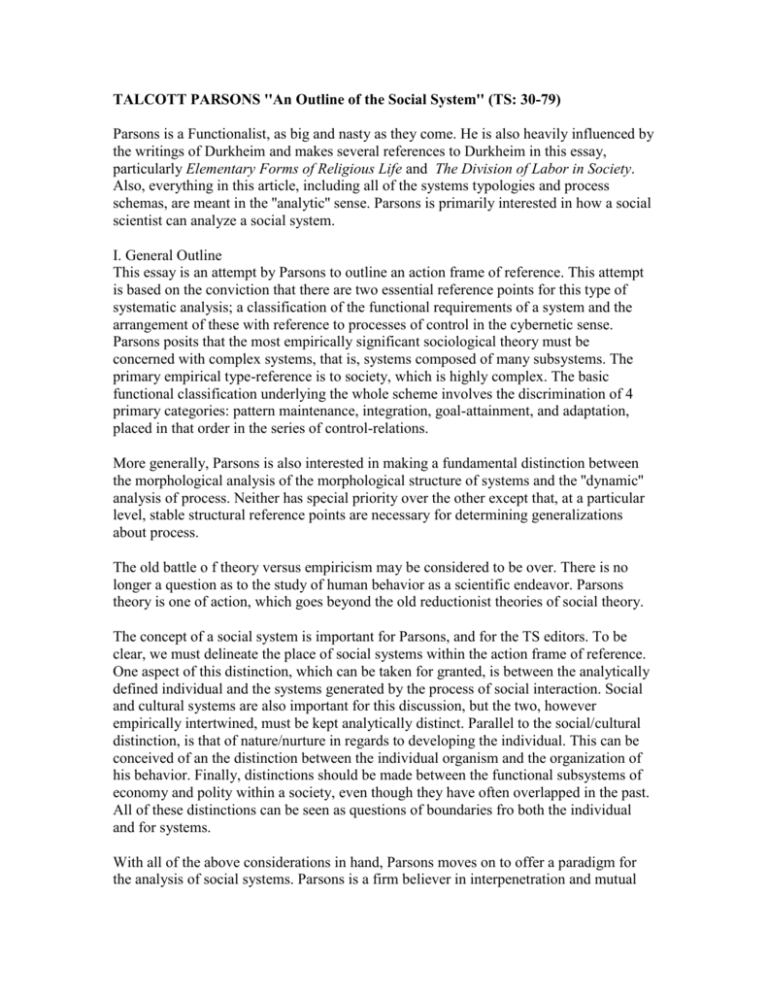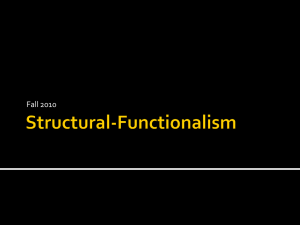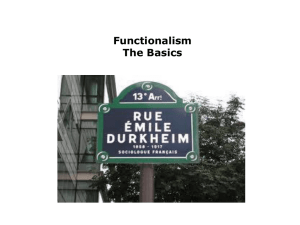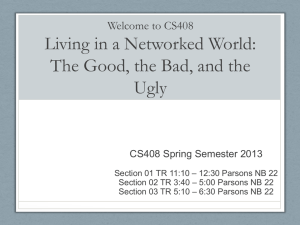TALCOTT PARSONS ``An Outline of the Social System`` (TS: 30-79)
advertisement

TALCOTT PARSONS ''An Outline of the Social System'' (TS: 30-79)
Parsons is a Functionalist, as big and nasty as they come. He is also heavily influenced by
the writings of Durkheim and makes several references to Durkheim in this essay,
particularly Elementary Forms of Religious Life and The Division of Labor in Society.
Also, everything in this article, including all of the systems typologies and process
schemas, are meant in the ''analytic'' sense. Parsons is primarily interested in how a social
scientist can analyze a social system.
I. General Outline
This essay is an attempt by Parsons to outline an action frame of reference. This attempt
is based on the conviction that there are two essential reference points for this type of
systematic analysis; a classification of the functional requirements of a system and the
arrangement of these with reference to processes of control in the cybernetic sense.
Parsons posits that the most empirically significant sociological theory must be
concerned with complex systems, that is, systems composed of many subsystems. The
primary empirical type-reference is to society, which is highly complex. The basic
functional classification underlying the whole scheme involves the discrimination of 4
primary categories: pattern maintenance, integration, goal-attainment, and adaptation,
placed in that order in the series of control-relations.
More generally, Parsons is also interested in making a fundamental distinction between
the morphological analysis of the morphological structure of systems and the ''dynamic''
analysis of process. Neither has special priority over the other except that, at a particular
level, stable structural reference points are necessary for determining generalizations
about process.
The old battle o f theory versus empiricism may be considered to be over. There is no
longer a question as to the study of human behavior as a scientific endeavor. Parsons
theory is one of action, which goes beyond the old reductionist theories of social theory.
The concept of a social system is important for Parsons, and for the TS editors. To be
clear, we must delineate the place of social systems within the action frame of reference.
One aspect of this distinction, which can be taken for granted, is between the analytically
defined individual and the systems generated by the process of social interaction. Social
and cultural systems are also important for this discussion, but the two, however
empirically intertwined, must be kept analytically distinct. Parallel to the social/cultural
distinction, is that of nature/nurture in regards to developing the individual. This can be
conceived of an the distinction between the individual organism and the organization of
his behavior. Finally, distinctions should be made between the functional subsystems of
economy and polity within a society, even though they have often overlapped in the past.
All of these distinctions can be seen as questions of boundaries fro both the individual
and for systems.
With all of the above considerations in hand, Parsons moves on to offer a paradigm for
the analysis of social systems. Parsons is a firm believer in interpenetration and mutual
influence. This means, that however important logical closure may be for a theoretical
ideal, empirically, social systems are conceived as open systems, engaged in complicated
processes of interchange with environing systems. This concept of open systems implies,
again, boundaries and their maintenance. A boundary means simply that a theoretically
and empirically significant difference between structures and processes internal to the
system and those external to it exists and tends to be maintained. Because of all of this,
we need to define a set of interdependent phenomena as a system, so as not to confuse a
statistical sample of the population with a true system.
Besides identifying a system in terms of its patterns and boundaries, a social system can
and should be analyzed in terms of three logically independent- i.e. cross-cutting - but
also interdependent, bases or axes of variability, or as they may be called, bases of
selective abstraction.
1. The first of these is involves a distinction between the structural and the functional.
The concept of structure designates the features of the system which can be treated as
constants over certain ranges of variation in the behavior of other significant elements of
the theoretical problem. The functional reference diverges from the structural in the
dynamic direction. Its primary purpose is integrative, mediating between the system's
structure and that imposed by environing systems.
2. A fundamental distinction must also be made between the two dynamic processes of
maintaining system equilibrium, and structural change in the system.
3. The hierarchy of relations of control. The basic subsystems of the general systems of
action constitute a hierarchical series of such agencies of control of the behavior of
individuals or organisms.
Parsons returns to the 4 functional imperatives of any system of action, given in order of
significance from the point of view of cybernetic control of action processes in the
system under consideration.
L - The function of pattern maintenance. The function of pattern maintenance refers to
the imperative of maintaining the stability of patterns of institutionalized culture defining
the structure of the system. There are two distinct aspects of this function. The first
concerns the character of the normative pattern itself; the focus lies in the structural
category of values. The second concerns its state of institutionalization, which concerns
the motivational commitment of the individual. A very central problem here is that of the
socialization of the individual, taken as the processes by which the values of the society
are internalized in an individual personality. Overall, systems do show a tendency to
maintain themselves (inertia).
G - The function of goal-attainment. Goal-attainment becomes a problem in so far as
there arises some discrepancy between the inertial tendencies of the system and its needs
resulting from interchange with the situation. A goal is therefore defined in terms of
equilibrium, and directional changes will tend to minimize the discrepancy between the
two systems. Goal -attainment, or goal- orientation is thus, by contrast with pattern
maintenance, tied to a specific situation. Systems often have a plurality of goals. For the
social system as such, goal-orientation concerns, therefore, not commitment to the values
of the society, but motivation to contribute what is necessary for the functioning of the
system.
A - The function of adaptation. Adaptation is another consequence of goal plurality. A
system has only so many set, scarce resources, and when goals are many, often one goal
must be sacrificed so the resources may be used to attain another goal. this means that the
system loses the benefits of the sacrificed goal. The sacrificed goal is chosen through the
function of goal-attainment. Adaptation is concerned with providing additional
disposable facilities independent of their relevance to any particular goal. More generally,
at the macroscopic level, goal-attainment is the focus of political organization, and
adaptation is the focus economic organization. Within a given system, goal-attainment is
a more important control then is adaptation.
I - The function of integration. In the control hierarchy, integration stands between the
functions of pattern-maintennce and goal-attainment. The functional problem of
integration concerns the mutual adjustments of segmented units or subsystems from the
point of view of their contributions to the effective functioning of the system as a whole.
In a highly differentiated society, the primary focus of the integrative mechanism is found
in the system of legal norms and the associated legal system. The system as a whole is
concerned most with the allocation of rights and obligations. For any given social system,
the integrative function is the focus of its most distinctive properties and processes.
II. Categories of Social Structure
Parsons conceives of social interaction as a structured affair. He provides a series of
structural categories, given in ascending order as role, collectivity, norm, and value.
These roughly cover the social structure from individual to social system.
Role is the essential starting point for individual interaction ( 2 or more people ) which
occurs in such a way as to constitute an interdependent system (as distinguished from a
social system). IN order for interaction to be stable, roles and actions must have meanings
and be governed by understood, shared rules. Rules define goals and the consequences of
ant given move by one player for the situation in which the other must make his choice.
Thus, there is a temporal element to interaction. However, rules do not determine or
prescribe any specific act. Facilities are provided, but they are generalized, and their
allocation between players depends upon each player's capacities to take advantage of
opportunities. The essential property is mutuality of orientation defined in terms of
shared patterns of normative culture, known as values. When two individuals interact in
the above ways, sharing a normative culture, and in so far as their behavior is
distinguishable from others by their participation and not others, they form a collectivity.
A role may now be defined as the structures, i.e. normatively regulated, participation of a
person in a concrete process of social interaction with specified, concrete role-partners.
Performing a role within a collectivity defined the category of membership, i.e. the
assumption of obligations of performance in that concrete interaction system. Obligations
correlatively imply rights. For any individual, there are many roles, and one role is only a
sector in his behavioral system, and hence of his personality. In addition, in any given
system, the concepts of role and collectivity are particularistic.
Norms and values, in contrast with role and collectivity, are universalistic concepts. It
may cut across all concrete collectivities in a given universe and apply to all roles of a
given type. The universalistic aspect of values implies that they are neither situationspecific, nor function-specific.
To sum up: Structurally speaking, then, the role component is the normative component
which governs the participation of individual persons in given collectivities. The
collectivity component is the normative culture which defines the values, norms, goalorientations, and ordering of roles for a concrete system of interaction of specifiable
persons; the component of norms which define expectations for the performance of
classes of differentiated units within the system - collectivities, or roles, as the case may
be; and values are the normative patterns defining, in universalistic terms, the patterns of
desirable orientation for the system as a whole, independent of the specification of
situation or of differentiated function within the system.
We now have enough to outline a schematic ideal type for a complex social system. the
main guiding line of the analysis is the concept that a complex social system consists of a
network of interdependent and interpenetrating subsystems, each of which, seen as the
appropriate level of reference, is a social system in its own right. (The infinitely
repressible thing). The starting point is the concept of a society, taken to be relatively
self-sufficient collectivity which cannot be said to be a differentiated subsystem of a
high-order collectivity oriented to most of the functional exigencies of a social system.
(All of these classifications are subjective, used and applied by an analyst.). The
functional exigencies take shape in three distinct manners: differentiation, segmentation
and specification.
There are several different modes of differentiation within societies. The most common,
even universal, is differentiation among kinship lines. Kinship is essentially the point of
articulation, i.e. interpenetration, between the structure of social systems and the relations
involved in the biological process of reproduction. Biologically, there are 3 crucial
structural components, (1) differences between sexes, (2) differences between old and
young, mature and immature, and (3) the fact hat the sexual union of two specific
individuals of opposite sexes is necessary to, and likely to result in, pregnancy and
reproduction. These 3 factors set up the nuclear family unit, and other diversified family
forms, around the conjugal bond of 2 people and its resultant offspring. Kinship
structures are also clearly subject to important processes of functional differentiation, and
have often become the locus for political and economic activities.
Because of the connection of paramount societal collectivity organization and political
function outlined, the functional differentiation of political from other structures also
tends to come near the top of the social hierarchy. There are two preliminary steps. The
first is to differentiate kinship units which carry high political responsibility, royals or
aristocrats, from common kinship units. The other the differentiation of the political from
the pattern-maintenace and integrative functions of the high-level units. Lower down, an
important problem here concerns the restrictions on the mobility of resources imposed by
the ascriptive aspect of kinship and its differentiation from political function. Even when
bureaucracy and systems not directly ties to kinship are instituted, higher-level kinship
units usually have an edge of advantage or resources. This imposes frustrating limits on
lower units.
Parsons perceives the intertwining of political and economic functions as an ongoing
problem, buried in many empirical examples. One must look closely, e.g. the function of
a business firm is primarily economic; its goal is production, but its internal organization
must be analyzed first in political terms. Economic function, as distinguished from the
political, involves the production and allocation of disposable resources.
Traditionally, one of the main criterion of the values of economic resources is relative
scarcity. The other most important one is general utility. The possibilities of generalizing
about physical commodities and human resources is thus inherently limited. The
utilization of scarce resources is dependent on the institutionalization of mechanisms
which, independent of any prior knowledge or commitment, make it possible to gain
access to wide ranges of different facilities as need for them develops. In known
societies, there are in particular two highly generalized mechanisms of this type, namely
political power and money. Both require the institutionalization of the disposability of
facilities.
Money is not a commodity here, but a very special mode of institutionalization of
expectations and commitments through communication. The usefulness of money as a
much more generalized facility is dependent on a system of markets and adequate rules
governing the continual flow of transactions through markets. Money has the primacy of
economic function.
Power is defined as the generalized capacity, independent of specific conditions
prescribed in advance, to influence the allocation of resources for the goals of the
collectivity through invoking the institutionalized obligations of member units, utilizing
such sanctions as are legitimized through these obligations and institutionalized roles
involved in the power system. Power is necessitated by the effectiveness which is
required for the political function. the mechanism of power are not nearly as structured as
those of money. Power is a mechanism regulating the process of making actual
commitments. Authority, on the other hand, comprises the general rules which govern the
making of specific binding decisions.
As used here, political and economic categories are generalized functional categories that
permeate the entire structure of the social system. But it is a two-way street. Just as
constraints on the commercial or competitive structure of markets are imposed by
impinging non-economic factors, so in many collectivities there are constraints on the
political primacy of their organization and orientation to situations.
No society can accept economic rationality as its most general societal value-orientation,
though it can place the economic highest among its functional priorities. This statement
also holds for other differentiated functional value-systems.
The same basic principles of the relations between structure and function, apply to
pattern-maintenance and the integrative functions, to the relations of the relevant
structures to each other and to the economic and political. First, societies will differ in so
far as structures with clear primacy of these functions have come to be differentiated
from those whose functions are more diffuse. Second, relevant structures will be located
at different levels on the scales of segmentation and specification, and may thus not be
directly comparable with each other.
With respect to pattern-maintenance, as a functional category, it is not meant to have
empirically static connotations. Analytically, specialization in both maintenance and
change in values should be placed in this category. the primary area of concern here is the
religion, placed within the realm of the cultural. Societal variance is great here, but even
when a specific religion is not institutionalized, religious values will be. Also a primary
component of pattern-maintenance is socialization of the individual, placed within the
realm of personality. Socialization universally involves at least one kinship unit, usually
the nuclear family, as the primary collective agent of early socialization. All more highly
differentiated societies have developed non-kinship structures centering about the
functions of formal education in which the higher-level patterns of normative culture and
systems of objects are internalized in the personality.
Structures with integrative primacy must follow some normative code. Norms must be
defined, interpreted, and implemented. The first imperative of a system of norms is
internal consistency. Second, there s the specification of higher-order norms to levels
where they can guide the action of the society's lower level structural units by defining
the situation for them. A major functional problem of a normative system concerns the
adjustments which occur because a social system is always involved in processes of
interchange with a changing environment. There seem to be three basic types of
processes of adjustment in these cases. 1. Keeping the regulatory norms at a sufficiently
high level of generality so that much of the adjustment can be left to the spontaneous,
unprescribed, action of the units themselves.
2. Altering the content of normative patterns to meet the varying functional needs without
threatening the stability of higher level systems.
3. A third process which operates, short of major structural changes, in the areas where
the other two are inadequate. ( It is unspecified.)
A final aspect of social structure is stratification. Here, the focus of institutionalized
stratification is legitimizing differential power and wealth, and more generally, access to
valued objects and statuses. Social class is the most common basis of stratification.
III. The Dynamics of Social Equilibrium
The analysis of dynamic processes at the equilibration level must center around two
categories of the system's components. The first are the resources which, starting from
outside the system, go through various phases as they pass through the system, and at
certain points are used in the system's functioning. The second are the types of
mechanisms which mediate these processes of generation and utilization of resources and
regulate their rates of flow, direction of use, etc. Money and power, as previously
discussed, are the prototypes of these mechanisms.
Parsons borrows the theoretical model of resources from economics because it is capable
of generalization. In this model, there are four factors of production, namely, land, labor,
capital, and organization. He is most concerned with applying the model's logical
structure, because level of specification of resources and qualitative differences in
resources make it difficult to apply the model directly to social systems theory.
None of the socially ultimate inputs consists in either actual physical objects or the
physical behavior of organisms. In an economic exchange, involving a physical
commodity, what changes hands is not the commodity, but property rights in the
commodity. Analytically, physical transfer of possession is a technological process, not a
social systems process. Like a feeder chain, the ultimate resources of a society should
comprise the ultimate outputs of the subsystems of the general system of action. Land is a
special case because it is neither consumed in the production process, nor is it produced.
In the society as a system, the analog of land is the institutionalized normative culture.
According to the paradigm, the inputs should be three: inputs respectively from the
personality - capacity to socialize motivational commitments, the behavioral organism plasticity which can be built into patterns of purposive response, and the cultural system information . Generally, output corresponding too the input if institutionalized normative
culture in the maintenance of the structure intact. The primary outputs of the other inputs
are as follows: personality system: goal-gratification, behavioral organism: patterning of
responses at the level of behavior, and cultural system: validation.
The resources complete this system as the thruput. They are consumed. Resource
processing occurs in three phases: generation, allocation and utilization.
Parsons shows some heavy Freudian influences here when he speaks of the socialization
of motivational capacity as an example of resource generation. He outlines the whole
process of developing sexuality, complete with Oedipal complex. But then, its back to
functionalism.
Allocation is made to operative units of the system, to which resources are committed for
use. The prototype for an allocative mechanism again comes from economics, it is the
market. The market makes possible a relatively functional allocation without much
centralized decision-making. It also allows for much differentiation. Another example
can be seen in the power mechanism's allocation of power in a politically differentiated
societ
Utilization is essentially a process of successively more particularized decision-making;
action-opportunities, facilities, and responsibilities are allocated more specifically at each
step. The most broadly defined stages are the allocation to the collectivity, to the role, and
to the task. The function of the collectivty is to define what is to be done; that of the role,
to define who is to do it; and that of the task level, how it is to be done.
Mechanisms controlling resource processes. Parsons again refers to power and money,
the two most studied of the mechanisms. Money is simultaneously both a measure of
value and a medium of exchange and it can function as both a facility and a reward.
Power is a step above money in the hierarchy of control mechanisms because power can
be used to control power, i.e. a government controlling its monetary system. Power
allows for greater flexibility and effectiveness without prior knowledge or specifications.
He also discusses real commitments, which I believe to be institutionalized role
commitments, but I'm not sure. They seem to have a lot to do with contracts and legal
agreements. Finally, there is integrative communication, which is also at the top of the
hierarchy of control mechanisms. The operational focus of this type of mechanism is the
motivational commitment of units of the system to the fulfillment of institutionalized
expectations.
In a broad sense then, the problem of the dynamics of social systems is not so much a
problem of transformation of energy as of the processing of information. Analyses of
these processes are in an early stage right now.
IV. The Problem of Structural Change
The processes of structural change may be considered the obverse of equilibrating
process; the distinction is made in terms of boundary maintenance. The control resources
of the system are adequate for its maintenance up to a well-defined set of points in one
direction: beyond that set of points, there is a tendency for a cumulative process of
change to begin, producing states progressively farther from the institutionalized patterns.
As observed, structural change in subsystems is an inevitable part of the equilibrating
process in larger system. Within this frame of reference, the problem of structural change
can be considered under three headings: (1) sources of tendencies towards change, (2) the
impact of these tendencies on the affected structural components, (3) possible
generalizations about trends and patterns of change.
Sources of change can be either exogenous or endogenous. Exogenous sources of change
are changes in the environment or environing social systems. Their impact is made felt
only through the endogenous tendencies to change which already exists in the units or
subsystems of the social system in question. Endogenous change itself is often perceived
as strain. A strain is a tendency to dis-equilibrium in the input-output balance between
two or more units of the system. Strain can be relieved by being fully resolved, by being
isolated or arrested, or by changing the structure itself. Since strain usually falls on
relations between units of the system, structural change to relieve the strain is defined as
alteration in normative culture defining the expectations governing that relation. Given
structural inertial tendencies, strain should occur only when lower-level control
mechanisms have failed. Sources of change may be myriad or multi-causal.
Disturbance in the system may result from the balance of inputs and outputs being thrown
off. The impact of these forces for change will vary in accordance with their magnitude,
proportion of system units affected, the strategic character of the affected unit(s), the
degree to which the forces affect functionally different units or sectors, and resistance of
system units. Empirically, it is hard to pinpoint these forces for change because they are
diffuse and seldom operate discreetly. By present definition, a change in the structure of a
social system is a change in its normative culture. At the most general level, it is a change
in the paramount value system.
Change can also affect the interaction of different levels of the social system, e.g.
normative culture and the personality system. However, symptoms of disturbance are
common to processes which do and do not cause change. Structural change is only one
possible outcome of strain.
The socialization of the child actually constitutes a process of structural change in one set
of structural components of social systems, namely, the role-patterns of the individual indeed, much of the foregoing paradigm has been derived from this source. The
socialization of the individual does not, however, comprise change in the social system of
society. This is a good illustration of Parsons' nested systems approach.
TALCOTT PARSONS: Talcott Parsons on Institutions and Social Evolution
Chapter 1: The Role of Theory in Social Research
In this short chapter, Parsons expresses his concern for what appears to be the complete
divorce between the empirically-minded and the theoretically minded in which each does
their type of research while degrading the work of the other. For instance, Parsons says,
''certain of the empirically minded are not merely not interested in attempting to
contribute to theory themselves, they are actively anti-theoretical'' (67). He makes the
same point of the theoretically minded. Although he is very sympathetic toward
empiricists who do not like to structure their research on firm theoretical grounds, he
argues the whether they would like to admit it or not, scientific endeavors cannot and do
not make much contribution to scientific knowledge unless they are ''guided by the
logical structure of a theoretical scheme.'' Parsons sees the principle functions of
analytical theory in research in the following four ways:
1) it provides a basis of selection for the important facts from the unimportant, given the
wealth of miscellaneous facts we have
2) it provides a basis for organization of the facts
3) it reveals the gaps in the existing knowledge and their importance
4) it provides a source of ''cross fertilization'' of related fields
Chapter 2: The Place of Ultimate Values in Sociological Theory
Basically what Parsons says in this chapter is that people strive to achieve ends and they
do so given the opportunities or means that are available to them (means-ends chain).
However, people's ''ultimate ends'' as well as how they achieve them are not chosen
randomly. Instead, the means by which people achieve their goals, etc., are defined and
established by the group of which they are a part. Parsons calls this a ''common system of
ultimate ends.'' Actions are governed by normative rules of the group or institution. In
other words, Parsons' concept of action is grounded in a normative framework.
Chapter 3: The Action Frame of Reference
A frame of reference is the starting point for analysis and is determined by the particular
vantage point and purposes. Mayhew says that ''the grounding of the normative in the
very concept of action as a necessary element of an action frame of reference, gives the
study of norms a solid theoretical foundation'' (8). Norms have special importance in
social life; they provide an action frame of reference for analyzing social structure and its
functions.
Chapter 4: Hobbes and the Problem of Order
Hobbes believed that people are guided by their passions. The good is simply what man
desires. However, there are many limitations on the extent to which these desires can be
realized. Therefore, in order to ''control'' people's desires, society has created a social
contract that exists between members of society. Through this contract men agree to give
up some liberties to the sovereign power and in return they receive security, or immunity,
from aggression by the force or fraud of others. Through this authority, the desires and
passions are held in check and order and security are maintained. Without it, men will
attempt to achieve their ends in the most efficient means available, in other words, force
or fraud. This will eventually lead to a state of war.
It is this social contract of Hobbes that is most interesting to Parsons. Hobbes' social
contract is synonymous with Parson's normative framework. He says that an ordered
social life cannot be founded on rational calculation alone; there must be a normative
framework to establish criteria of choice that will provide for social control of disruptive
conduct.
Chapter 5: Pattern Variables
Pattern variables are ''the principle tools of structural analysis outlining the derivation of
these categories from the intrinsic logic of social action -- the inherent dilemmas of
choice facing actors'' (10). In this chapter Parsons argues that there are a strictly limited
and defined set of alternatives or choices that can be made, and the relative primacies
given to choices constitute the ''patterning of relational institutions.'' These choices or
alternatives are called orientation-selection.
There are five pattern variables of role-definition that Parsons discusses, although he says
that there are many more possibilities. The first is the gratification-discipline dilemma:
affectivity vs. affective-neutrality. The dilemma here is in deciding whether one
expresses their orientation in terms of immediate gratification (affectivity) or whether
they renounce immediate gratification in favor of moral interests (affective-neutrality).
parsons says, ''no actor can subsist without gratifications, while at the same time no
action system can be organized or integrated without the renunciation of some
gratifications which are available in the given situation'' (107).
The second set of pattern variables of role-definition are the private vs. collective interest
dilemma: self-orientation vs. collectivity orientation. In this case, one's role orientation is
either in terms of her private interests or in terms of the interests of the collectivity.
Parsons explains, ''a role, then, may define certain areas of pursuit of private interests as
legitimate, and in other areas obligate the actor to pursuit of the common interests of the
collectivity. The primacy of the former alternative may be called ''self-orientation,'' that
of the latter, ''collectivity-orientation'' (107).
The third pair of pattern variables are the choice between types of value-orientation
standard: universalism vs. particularism. Simply put, ''in the former case the standard is
derived from the validity of a set of existential ideas, or the generality of a normative
rule, in the latter from the particularity of ... an object or of the status of the object in a
relational system'' (109). Example: the obligation to fulfill contractual agreements vs.
helping someone because she is your friend.
The fourth pair of pattern variables are achievement vs. ascriptive role behavior: the
choice between modalities of the social object. Achievement-orientation roles are those
which place an emphasis on the performances of the people, whereas ascribed roles, the
qualities or attributes of people are emphasized independently of specific expected
performances.
The final pair of pattern variables are specificity vs. diffuseness: the definition of scope
of interest in the object. If one adopts an orientation of specificity towards an object, it
means that the definition of the role as orienting to the social object in specific terms. In
contrast, in a diffuse orientation, the mode of orientation is outside the range of
obligations defined by the role-expectation.
Chapter 7: Integration and Institutionalization in the Social System
Institutionalization: By institutionalization Parsons meant the integration of roles and
sanctions with a generalized value system or normative framework which all members
share. He states, ''institutionalization is an articulation or integration of the actions of a
plurality of actors in a specific type of situation in which the various actors accept jointly
a set of harmonious rules regarding goals and procedures'' (118).
Institutionalizing Roles: Parsons says that the social system of the institution must
contain an allocative process by which the problem of who is to get what, who is to do
what, and the manner and conditions under which it is to be done is made explicit. If this
is not done, the social system will fail and will make way for another system. If it does
occur, integration will be achieved. The function of allocation of roles, facilities, and
rewards, therefore, must be established within the social system. Access to roles is
determined by qualifications. Access to facilities is determined by position. One is given
facilities to help to achieve the goals set forth by the duties of the position they occupy.
The purpose of facilities is the fulfillment of role-expectations. Rewards have the
function of maintaining or modifying motivations. Therefore, access to rewards is
determined by achievement or how well one does her work.
The Integration of the Social System: Social integration of the social system takes place
when members are governed by a common value-orientation, when the common values
are motivationally integrated in action as a collectivity, and when the people are given
and take responsibility for their role-expectation in that they take responsibility for the
definition and enforcement of the norms governing the allocative processes and take
responsibility for the conduct of communal affairs.
Chapter 9: Illness and the Role of the Physician
Parsons defines illness as a deviant behavior because, as a sick person, whether mentally
or physically, one is not able to perform the functions or obligations to society. He states,
''behavior which is defined in sociological terms as failing in some way to fulfill the
institutionally defined expectations of one or more of the roles in which the individual is
implicated in the society'' (146). He deals with four issues here: the processes of genesis
of illness, the role of the sick person as a social role, aspects of the role of the physician
and their relation to the therapeutic process, and the way in which both roles fit into the
general equilibrium of the social system.
In the first issue, that of the processes of genesis of the illness, mental illness is assumed.
Parsons suggests that the genesis of illnesses results from something that has gone wrong
in a person's relationships to others during the process of social interaction. The support a
person receives from those surrounding her in which she is made to feel a member of the
group as well as the upholding of values of the group may be lacking resulting in the
person becoming pathological.
In the second issue, the role of the sick person is considered a social role. First, the sick
person is made exempt from normal social obligations. Then she is exempted from
certain responsibilities of her own state. Third, given the role of the sick relinquishes one
from the claim to full legitimacy. Fourth, being sick is defined as needing help; the sick
person makes the transition to the additional role of patient and as such has certain
obligations to fulfill.
The third issue, the aspects of the role of the physician and their relation to the
therapeutic process are discussed. Parsons says that there are four main conditions of
successful psychotherapy. The first is support which signifies the acceptance of the sick
person as a member of a social group. The second is a special permissiveness to express
wishes and fantasies which would ordinarily not be permitted in normal social
relationships. The third is that the therapist does not reciprocate the expectations of the
patient. The fourth is the conditional manipulation of sanctions by the therapist -- the
giving and withholding of approval.
The final issue that Parsons discusses is how the illness/sick person, the physician, and
well as the psychotherapy are built into the structure of society.
Chapter 15: On the Concept of Influence
Ways of Getting Results in Interaction: Parsons argues that there are at least four ways of
getting results in interaction. The first is through inducement of offering someone
something that they want so that they will comply. The second is through deterrence of
suggesting that by not complying something bad will happen to the person. The third
means is through activation of commitment or suggesting to the person why it would be
wrong, in the person's viewpoint, to refuse to comply. The fourth means is through
persuasion or offering reasons why it would be a good thing for him or her to comply,
independent of situational advantages. Parsons presents the following diagram to
illustrate his point:
CHANNEL
SANCTION
Intentional
Situational
Positive
persuasion
inducement
Negative
activation
of
commitments
deterrence
This he calls his paradigm of modes of gaining ends.
Parsons defines influence as ''a means of persuasion. It is bringing about a decision on
alter's part to act in a certain way because it is felt to be a 'good thing' for him, on the one
hand independently of contingent or otherwise imposed changes in his situation, on the
other hand for positive reasons, not because of the obligations he would violate through
noncompliance'' (236). In other words, one has influence because of who they are,
because they hold some title, etc., that makes people believe in them. Parsons states, ''the
same statement will carry more weight if made by someone with a high reputation for
competence, for reliability, for good judgment, etc., than by someone without this
reputation ... It is not what he is saying ... but what 'right' he has to expect to be taken
seriously.'' (238-9). Persuasion is done in common interest. It is not in the interest of the
persuader, but in the interest of the person being persuaded that the outcome would
benefit. An example of this is a doctor and a patient. The doctor has influence because of
who she is. She has a degree and training that gives credibility, and the aim she has is for
the good of the patient.
Types of Influence. There are four types of influence: political, fiduciary, influence
through appear to different loyalties, and influence oriented to the interpretation of
norms. In political influence, there is a directly significant relation between influence and
power. Fiduciary influence refers to the ability to allocate resources in a system where
both collectivities and their goals are plural and justification of each among the plural
goals is problematic. Influence through appeal to differential loyalties refers to
commitments grounded in institutionalized values. It is a matter of justifying assuming
particular responsibilities in the context of a particular collectivity. The final type of
influence, that of influence oriented to the interpretation of norms, refers to the
interpretation of legal norms of the judicial process.
Chapter 19: Evolutionary Universals in Society
Four features of human societies at the level of culture and social organization were cited
as having universal and major significance as prerequisites for socio-cultural
development: technology, kinship organization based on an incest taboo, communication
based on language, and religion. Primary attention, however, was given to six
organizational complexes that develop mainly at the level of social structure. The first
two, particularly important for the emergence of societies for primitiveness, are
stratification, involving a primary break with primitive break with primitive kinship
ascription, and cultural legitimation, with institutionalized agencies that are independent
of a diffuse religious tradition.
Fundamental to the structure of modern societies are, taken together, the other four
complexes: bureaucratic organization of collective goal-attainment, money and market
systems, generalized universalistic legal systems, and the democratic association with
elective leadership and mediated membership support for policy orientations. Although
these have developed very unevenly, some of them going back a very long time, all are
clearly much more than simple inventions of particular societies.
Perhaps a single theme tying them together is that differentiation and attendant reduction
in ascription has caused the initial two-class system to give way to more complex
structures at the levels social of stratification and the relation between social structure and
its cultural legitimation. First, this more complex system is characterized by a highly
generalized universalistic normative structure in all fields. Second, subunits under such
normative orders have greater autonomy both in pursuing their own goals and interests
and in serving others instrumentally. Third, this autonomy is linked with the probability
that structural units will develop greater diversity of interests and subgoals. Finally, this
diversity results in pluralization of scales of prestige and therefore of differential access
to economic resources, power, and influence.
TALCOTT PARSONS: ''Suggestions for a Sociological Approach to the Theory of
Organizations''
1. MAIN ARGUMENT
Parson's version of sociological explanation of organizational theory. He attempted to
define organization by locating it systematically in the structure of the society in relation
to other categories of social structure. He defines an organization as ''a social system
oriented to the attainment of a relatively specific type of goal, which contributes to a
major function of a more comprehensive system, usually the society'' (63).
2. OUTLINE (AGIL SCHEME)
He referred to his basic classification of the functional problem of social systems (AGIL).
This classification distinguished four main categories:
-the value system - which defines and legitimized the goals of the organization (L)
-the adaptive mechanisms - which concern mobilization of resources (A)
-the operative code - mechanisms of the direct process of goal implementation (G)
-the integrative mechanisms (I)
1) - (L) Its value system defining the societal commitments of which its functioning
depends. This value system must be a subvalue system of a higher-order one, since the
organization is always defined as a subsystem of a more comprehensive social system.
From this concept, Parsons maintained two conclusions. First, the value system of the
organization must imply basic acceptance of the more generalized values of the
superordinate system. Secondly, on the requisite level of generality, the most essential
feature of the value system of an organization is the valuative legitimation of its place or
role in the superordinate system.
2) - (A) Its mechanisms of resource procurement. The problem of mobilizing fluid
resources concerns one major aspect of the external relations of the organization to the
situation in which it operates. The resources which the organization must utilize are the
factors of production as these concepts are used in economic theory; land, labor, capital
and organizations (refers to the function of combining the factors of production in such
ways as to facilitate the effective attainment of the organization's goal).
3) - (G) Its operative mechanism centering about decision making in the fields of policy,
allocation, and integration. The policy decision meant decisions which relatively directly
commit the organization as a whole and which stand in relatively direct relation to its
primary functions. Parsons noted that the critical feature of policy decisions is the fact
that they commit the organization to a whole to carry out their implications. The
allocative decisions relate to the distribution of resources within the organization and the
delegations of authority. From these points, there are two main aspects of the allocative
decision process; one concerns mainly personnel, the other financial and physical
facilities. The coordination decisions concern with the integration of the organization as a
system.
4) - (I) Its institutional patterns which link the structure of the organization with the
structure of the society as a whole. The problem concern rather the compatibility of the
institutional order under which the organization operates with other organizations and
social units, as related to integrative exigencies of the society as a whole. This integrative
problem can be generalized to both human agents and interorganizational integration.
Conclusion: The same basic classification of the functional problems of social systems
was used to establish point of reference for a classification of types of organization, and
broadest outline of a proposed classification was sketched. Then, Parsons suggested some
illustrative cases by a rapid survey of some of the principal business, military, and
academic organizations.
TALCOTT PARSONS: The Professions and Social Structure
This chapter and the piece on age and sex can be seen as attempts to apply Parsons'
theories to real life situations. In the case of business and the professions, he's looking at
how our ''society'' as an organism, maintains itself. Two of Parsons' four functional needs
of society - integration (coordinating system parts) and latency (managing tensions
between parts and generating new parts) - are solved in this article by what he calls
''functional specificity''. (compare to Durkheim).
Parsons begins by wondering why the professions are so highly developed, and why there
is such a highly refined division of labor nowadays. (He rejects the idea that it is simply
individuals' utilitarian self-interest. He says it is part of society, institutional. **He wants
to prove that ''the acquisitiveness of moderns business is institutional rather than
motivational.'' Here institutional = cultural = given part of social structure.)
Three important elements distinguish our society from others and contribute to the unique
importance of professions in our society.
1. In our society, scientific rationality - that is, not accepting traditional explanations just
because they are traditional, and therefore searching for better ways and explanations - is
''institutional, a part of a normative pattern.'' This is to say, scientific rationality is not just
something that comes natural to all human beings.
2. Furthermore, certain people have authority in certain realms but in no others. For
instance, regardless of their financial backgrounds or upbringing, doctors are given
authority in the field of medicine because it is their specialty. This is what Parsons calls
the ''functional specificity'' of technical competence or authority. In contrast to
commercial relations, which are functionally specific, kin relations are functionally
diffuse. Your grandma has authority because she's your grandma, not because of their
technical expertise. (Liken functional specificity to Weber on bureaucracy - officeholders can give orders because of authority of the office.) Parsons calls for a thorough
study of functional specificity, since it is a product of our unique modern D of L.
3. Related to the last thing, there are two kinds of relations among people, universalistic
and particularistic. The more contexts in which you know someone, like a relative or a
friend, the less possible it is to abstract that person's personality from the particular role
they play at one time. For instance, a person who has her elderly parent living with her
will treat the parent much differently than she would treat a tenant who is a stranger. The
mother is regarded as a particular individual, mom. The other tenant is regarded as any
other tenant would be, by a ''universalistic'' rule for how landlords treat tenants. (Think of
Simmel, content and form of relations - parent relations have more content because of
different contexts, not a purely formal relation.)
But are professions and business really all that different? No, if we think of them both as
having the goal of ''success.'' People wish to succeed at whatever vocation their talent
brings them to, be they doctors, scientists, painters or financial analysts.
But this is only the case in the normal condition of society, a ''well-integrated'' situation.
If achievement fails to bring recognition, or if you get recognition for doing nothing or
the wrong thing, this causes strain. (Think of Merton) Strain leads to profiteering in the
professions and shady practices in business.
It is not accurate to say that business folks are purely egoistic nor that professionals are
purely altruistic. Both have the same sorts f motivation, and differences in normative
behaviors are institutionally defined definitions of the situation. System is maintained by
a complex balance of diverse social forces.
TALCOTT PARSONS: Age and Sex in the Social Structure of the United States
This is another attempt to make Parsons' theories relevant. This piece deals mostly with
the functional needs of integration and latency, where different age and sex groups can be
seen as the different elements of an organism. To some extent, it deals with the question
of how to reconcile individual with social needs.
Parsons asserts that our society is unique in that our children of both sexes are treated
alike, relative to other societies. The main reason for this similarity is that children are
given education that focuses mostly on liberal arts rather than vocations.
In spite of the ''conspicuous'' exception that in the job world, men and women in this
society share an underlying structural equality. (I'm just telling you what he says.)
Education through college is merit-based and there is little discrimination until you get to
postgrad, where the strict focus on vocation leads to more sex-based discrimination.
Elsewhere Parsons asserts that it is functional to have a woman at home raising the
children and making the man's home life run smoothly, so he can dedicate himself to his
career. Women need to be educated, he implies, because they need to life up to
expectations which come with being the wife of a man of a certain status. He is where she
gets her status.
If she isn't smart enough to find ways to entertain herself by following the ''good
companion'' pattern, a women may choose to follow the glamour gal routine, going for
clothes and makeup. Striving for success in these two realms is functional because these
patterns keep women from competing with men. However, since these women have
liberal arts educations, they may undergo such strain that it is no surprise that they often
exhibit neurotic behavior. This sex-based differentiation comes from adolescent ''youth
culture,'' where boys value things counter to adult male responsibility (like sport, booze,
and girlies) and girls go for the glamour gal look. The girls' role is counter to their adult
expectation of becoming mommies, but nonetheless prepares them to accept their place
relative to the men's world.
As people age, women whose children are grown get bored and either shop more or work
for benefit organizations. Men and women both romanticize the days when their options
were open to them, so men may drink and hang out with younger, attractive women.
Women may get neurotic.
All this is an example of how society tries to regulate its functions, in spite of strain. Here
we find problems of latency, where tensions arise between parts, such as women who are
smart and educated enough to have ''men's'' jobs but would then force too much
competition. There are also problems of integration or coordinating the parts of the
system, especially in the case of preparing boys for the adult world in a society where
their role models are absent ('cause they're at work all the time). I don't think I need to
spend much time briefing you all on potential criticisms of this particular little chapter
(Don't men themselves have anything to do with keeping women out? Since when has
there been gender equality in the schools? Why is this system functional anyway!?!).
Let's say, in the unlikely chance we get asked about it, we'll have a field day.








